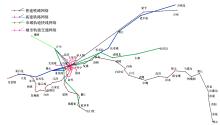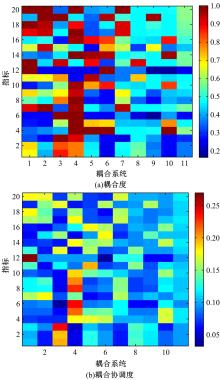吉林大学学报(工学版) ›› 2021, Vol. 51 ›› Issue (6): 2040-2050.doi: 10.13229/j.cnki.jdxbgxb20200701
• 交通运输工程·土木工程 • 上一篇
多式轨道交通网络的耦合协调度
- 1.西南交通大学 交通运输与物流学院,成都 611756
2.西南交通大学 综合交通运输智能化国家地方联合工程实验室,成都 611756
3.中铁第一勘察设计院集团有限公司,西安 710043
4.中国铁路西安局集团有限公司,西安 710054
5.西华大学 汽车与交通学院,成都 610039
Coordination degree of multimodal rail transit network
Feng XUE1,2( ),Chuan-lei HE3,Qian HUANG4,Jian LUO5(
),Chuan-lei HE3,Qian HUANG4,Jian LUO5( )
)
- 1.School of Transportation and Logistics,Southwest Jiaotong University,Chengdu 611756,China
2.National United Engineering Laboratory of Integrated and Intelligent Transportation,Southwest Jiaotong University,Chengdu 611756,China
3.China Railway First Survey and Design Institute Group Co. ,Ltd. ,Xi'an 710043,China
4.China Railway Xi'an Group Co. ,Ltd. ,Xi'an 710054,China
5.School of Automobile and Transportation,Xihua University,Chengdu 610039,China
摘要:
为研究多式轨道交通子网络系统之间的耦合关系,基于复杂网络理论计算其拓扑指标值及耦合协调度,构建了多式复合网络拓扑模型。分析了复合网络的拓扑指标值变化,提出了结合网络规模、拓扑结构、鲁棒性、运输能力、换乘比例和功能造价等因素的多式轨道交通网络耦合协调度计算方法,并运用重庆2019年10月的轨道交通网络进行了实例分析。结果表明:复合后的网络具有更大的平均度、更小的最短路径长度,这一时期复合网络的耦合度为0.988,协调度为0.678,耦合程度较高,协调程度一般;4个子系统各指标下的耦合度和协调度数值上差异较大,但都随着系统数量的增多,整体的耦合性和协调性大多呈下降趋势。
中图分类号:
- U113
| 1 | Erdős P, Rényi A. On the evolution of random graphs[J]. Publ Math Inst Hung Acad Sci, 1960, 5(1): 343-347. |
| 2 | Watts D J, Strogatz S H. Collective dynamics of small world networks[J]. Nature, 1998, 393(6684):440-442. |
| 3 | Barabási A L, Albert R. Emergence of scaling in random networks[J]. Science, 2011, 286(15):509-512. |
| 4 | 方锦清, 汪小帆, 郑志刚, 等. 一门崭新的交叉科学: 网络科学(上)[J]. 物理学进展, 2007, 27(3): 239-343. |
| Fang Jin-qing, Wang Xiao-fan, Zheng Zhi-gang, et al. New interdisciplinary science: network science(I)[J]. Progress in Physics, 2007, 27(3):239-343. | |
| 5 | Amaral L A N, Scala A, Barthélémy M, et al. Classes of small-world networks[J]. Proceedings of the National Academy of Sciences of the United States of America, 2000, 97(21):11149-11152. |
| 6 | Sienkiewicz J, Holyst J A. Public transport systems in Poland: from Bialystok to Zielona Gora by bus and tram using universal statistics of complex networks[J]. Acta Physica Polonica, 2005, 36(5): 1771-1778. |
| 7 | Lämmer S, Gehlsen B, Helbing D. Scaling laws in the spatial structure of urban road networks[J]. Physica A Statistical Mechanics & Its Applications, 2006, 363(1): 89-95. |
| 8 | 张晋, 梁青槐, 贺晓彤. 北京市地铁网络拓扑结构复杂性研究[J]. 北京交通大学学报, 2013, 37(6): 78-84. |
| Zhang Jin, Liang Qing-huai, He Xiao-tong. Study on the complexity of Beijing metro network[J]. Journal of Beijing Jiaotong University, 2013, 37(6): 78-84. | |
| 9 | 包云, 刘军, 李婷. 中国铁路旅客列车服务网络性质研究[J]. 铁道学报, 2012, 34(12): 8-15. |
| Bao Yun, Liu Jun, Li Ting. Properties of Chinese railway passenger train service network[J]. Journal of the China Railway Society, 2012, 34(12): 8-15. | |
| 10 | 宗跃光, 陈眉舞, 杨伟, 等. 基于复杂网络理论的城市交通网络结构特征[J]. 吉林大学学报: 工学版, 2009, 39(4): 910-915. |
| Zong Yue-guang, Chen Mei-wu, Yang Wei, et al. Structure characteristic of urban composite traffic net‐work based on complex network theory[J]. Journal of Jilin University(Engineering and Technology Edition), 2009, 39(4): 910-915. | |
| 11 | 卫振林, 甘杨杰, 赵鹏. 城市复合交通网络的若干特性研究[J]. 交通运输系统工程与信息, 2015, 15(1): 106-111. |
| Wei Zhen-lin, Gan Yang-jie, Zhao Peng. Characteristic research of urban complex traffic network[J]. Journal of Transportation Systems Engineering and Information Technology, 2015, 15(1): 106-111. | |
| 12 | 薛锋, 何传磊, 黄倩. 成都地铁网络的关键节点识别方法及性能分析[J]. 中国安全科学学报, 2019, 29(1): 93-99. |
| Xue Feng, He Chuan-lei, Huang Qian. Key node identification of Chengdu metro network and network performance analysis[J]. China Safety Science Journal, 2019, 29(1):93-99. | |
| 13 | 林鹏飞, 翁剑成, 付宇, 等. 基于刷卡数据的轨道交通加权网络结构特征[J]. 吉林大学学报:工学版, 2020, 50(3): 956-962. |
| Lin Peng-fei, Weng Jian-cheng, Fu Yu, et al. Structure characteristics of rail transit weighted network based on smart card data[J]. Journal of Jilin University(Engineering and Technology Edition), 2020,50(3):956-962. | |
| 14 | 姜磊, 柏玲, 吴玉鸣. 中国省域经济、资源与环境协调分析——兼论三系统耦合公式及其扩展形式[J]. 自然资源学报, 2017, 32(5): 788-799. |
| Jiang Lei, Bai Ling, Wu Yu-ming. Coupling and coordinating degrees of provincial economy, resources and environment in China[J]. Journal of Natural Resources, 2017, 32(5):788-799. | |
| 15 | Tang Z. An integrated approach to evaluating the coupling coordination between tourism and the environment[J]. Tourism Management, 2015, 46: 11-19. |
| 16 | 黄文成, 帅斌, 庞璐, 等.基于耦合协调度的道路危险品运输系统风险评价[J]. 中国安全科学学报, 2016, 26(6): 117-122. |
| Huang Wen-cheng, Bin Shuai, Pang Lu, et al. Research on coupling coordination degree based method for assessing risk in road dangerous goods transport system[J]. China Safety Science Journal, 2016, 26(6):117-122. | |
| 17 | 薛锋, 袁野. 基于耦合协调度模型的综合运输体系支撑力研究[J]. 交通运输工程与信息学报, 2018, 16(1): 24-31. |
| Xue Feng, Yuan Ye. Research on the supporting capability of comprehensive transportation systems using coupling coordinate model[J]. Journal of Transportation Engineering and Information, 2018, 16(1):24-31. | |
| 18 | 徐凤, 朱金福, 杨文东. 高铁-民航复合网络的构建及网络拓扑特性分析[J]. 复杂系统与复杂性科学, 2013, 10(3): 1-11. |
| Xu Feng, Zhu Jin-fu, Yang Wen-dong. Construction of high-speed railway and airline compound network and the analysis of its network topology characteristics[J]. Complex Systems and Complexity Science, 2013, 10(3): 1-11. | |
| 19 | 杨捷. 基于复杂网络的伏牛山区路网与县域经济协调发展研究[D]. 开封:河南大学环境与规划学院, 2019. |
| Yang Jie. Research on coordinated development of the road network and the county economy of Funiu mountain area based on complex network[D]. Kaifeng: College of Environment and Planning, Henan University, 2019. | |
| 20 | 蒋洁滢. 区域轨道交通综合运能匹配评价方法研究[J].中国铁路, 2019, 57(9): 90-94. |
| Jiang Jie-ying. Research on evaluation methods of comprehensive transport capacity matching for regional rail transit[J]. China Railway, 2019, 57(9):90-94. | |
| 21 | 南天伟. 铁路综合客运枢纽衔接方式运营匹配性评价及优化[D]. 北京: 北京交通大学交通运输学院, 2015. |
| Tian-wei Nan. Study on the evaluation and optimization scheme for passengers'transfer modes in railway transport hub[D]. Beijing: School of Traffic and Transportation, Beijing Jiaotong University, 2015. | |
| 22 | 陈小鸿, 周翔, 乔瑛瑶. 多层次轨道交通网络与多尺度空间协同优化——以上海都市圈为例[J]. 城市交通, 2017, 15(1): 20-30, 37. |
| Chen Xiao-hong, Zhou Xiang, Qiao Ying-yao. Coordination and optimization of multilevel rail transit network and multi-scale spatial layout: a case study of Shanghai metropolitan area[J]. Urban Transport of China, 2017, 15(1): 20-30, 37. | |
| 23 | 赵国堂, 周诗广. 我国市域铁路发展现状及未来展望[J].中国铁路, 2018,57(8):1-10. |
| Zhao Guo-tang, Zhou Shi-guang. Today and future of suburban railway in china[J]. China Railway, 2018, 57(8):1-10. |
| [1] | 陆文琦,周天,谷远利,芮一康,冉斌. 基于张量分解理论的车道级交通流数据修复算法[J]. 吉林大学学报(工学版), 2021, 51(5): 1708-1715. |
| [2] | 卢凯,吴蔚,林观荣,田鑫,徐建闽. 基于KNN回归的客运枢纽聚集人数组合预测方法[J]. 吉林大学学报(工学版), 2021, 51(4): 1241-1250. |
| [3] | 钱榕,张茹,张克君,金鑫,葛诗靓,江晟. 融合全局和局部特征的胶囊图神经网络[J]. 吉林大学学报(工学版), 2021, 51(3): 1048-1054. |
| [4] | 彭博,张媛媛,王玉婷,唐聚,谢济铭. 基于自动编码机-分类器的视频交通状态自动识别[J]. 吉林大学学报(工学版), 2021, 51(3): 886-892. |
| [5] | 张健,吴坤润,杨敏,冉斌. 智能网联环境下交叉口双环自适应控制模型[J]. 吉林大学学报(工学版), 2021, 51(2): 541-548. |
| [6] | 王殿海,沈辛夷,罗小芹,金盛. 车均延误最小情况下的相位差优化方法[J]. 吉林大学学报(工学版), 2021, 51(2): 511-523. |
| [7] | 宋现敏,张明业,李振建,王鑫,张亚南. 动态公交专用道的设置及其仿真分析评价[J]. 吉林大学学报(工学版), 2020, 50(5): 1677-1686. |
| [8] | 贾洪飞,丁心茹,杨丽丽. 城市潮汐车道优化设计的双层规划模型[J]. 吉林大学学报(工学版), 2020, 50(2): 535-542. |
| [9] | 尹超英,邵春福,王晓全,熊志华. 考虑空间异质性的建成环境对通勤方式选择的影响[J]. 吉林大学学报(工学版), 2020, 50(2): 543-548. |
| [10] | 张大伟,祝海涛. 考虑行人差异性的人群疏散最优决策理论模型[J]. 吉林大学学报(工学版), 2020, 50(2): 549-556. |
| [11] | 常玉林,袁才鸿,孙超,张鹏. 基于改进元胞传输模型的城市路网实际阻抗计算方法[J]. 吉林大学学报(工学版), 2020, 50(1): 132-139. |
| [12] | 宗长富,文龙,何磊. 基于欧几里得聚类算法的三维激光雷达障碍物检测技术[J]. 吉林大学学报(工学版), 2020, 50(1): 107-113. |
| [13] | 隋振,姜源. 基于MIMO类脑情感学习回路的横-纵向综合控制驾驶员模型[J]. 吉林大学学报(工学版), 2020, 50(1): 140-146. |
| [14] | 别一鸣,姜凯,汤茹茹,王琳虹,熊昕宇. 考虑方案过渡影响的单点交通控制时段划分方法[J]. 吉林大学学报(工学版), 2019, 49(6): 1844-1851. |
| [15] | 谷远利, 张源, 芮小平, 陆文琦, 李萌, 王硕. 基于免疫算法优化LSSVM的短时交通流预测[J]. 吉林大学学报(工学版), 2019, 49(6): 1852-1857. |
|
||







